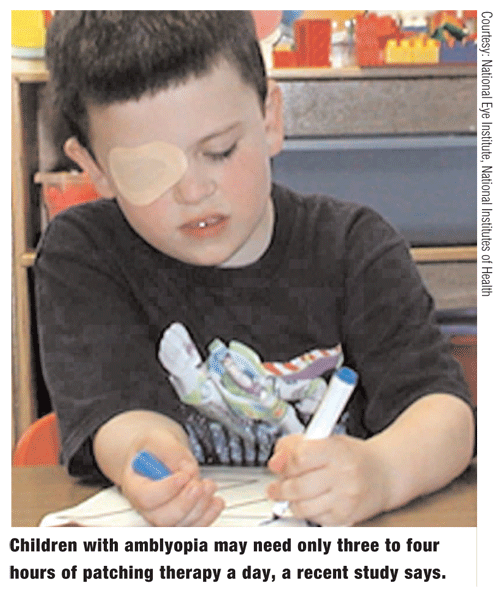Children with amblyopia only require occlusion therapy (patching) for three to four hours daily, not the maximal dose of 12 hours a day traditionally prescribed, or  even six hours daily, according to a study in the September issue of British Medical Journal.
even six hours daily, according to a study in the September issue of British Medical Journal.
Researchers at
Results showed no significant difference in visual acuity between the two groups. However, the mean number of hours a day patients actually wore the patch was not significantly different (4.2 hours in the group prescribed six hours and 6.2 hours in the 12-hour group).
On further analysis, the researchers found that visual improvement was similar for those children who received three to six hours a day or six to 12 hours a day, but significantly worse for children who received less than three hours a day. Children younger than age 4 required significantly less occlusion (under three hours a day) than older children to correct their vision. Also, patching beyond 12 weeks did not provide additional benefit.
These results suggest that an initial dose rate of three to four hours a day should be a clinical priority, the authors say, adding that this could be reduced for children younger than age 4.
No doubt, these findings are good news to amblyopic patients (and the prescribing O.D.). Depending on the depth of amblyopia, patching for six and/or 12 hours may just not be feasible, says Dominick Maino, O.D., M.Ed., a professor in the Pediatric/Binocular Vision Service in the Illinois Eye Institute, a part of Illinois College of Optometry, and editor of Optometry and Vision Development.
Dr. Maino says he usually recommends two hours of patching with one hour of active home hand-eye therapy and one hour of passive activity, such as watching television, eating or playing video games.
Stewart CE, Stephens DA, Fielder AR, Moseley MJ. Objectively monitored patching regimens for treatment of amblyopia: randomised trial. BMJ 2007 Sep 13; [Epub ahead of print].

